Math 300, Section 101
Analytic Landscapes
and Phase Portraits

Above is the complex plane, with argument indicated by colour.
Positive real numbers are red, negative real numbers cyan. Positive
real multiplies of the standard primitive cube root of unity are green,
positivce real multiplies of the other primitive cube root of unity
are blue. As we move around the origin in the positive direction
(i.e., counterclockwise), we cycle through the spectrum once, with
colours appearing in the order: red, yellow, green, cyan, blue,
magenta, and back to red. The origin is black, it has no
argument/colour associated to it.

This is the same thing with absolute values indicated by a saw function: as
the absolute value grows, the colours get lighter and lighter, until
they revert to dark grey, and this pattern is repeated ad infinitim.
So the circles indicate loci of complex numbers of equal absolute
values.


These are two depictions of the analytic landscape of the function
f(z)=z. The elevation in this landscape is given by |z|, i.e., over
the point z in the complex plane, the elevation of this cone is |z|.
The landscape is coloured according to the argument of z. Thus we
have the same colour pattern as before, except it is now on the cone,
instead of on the plane. Unfortunately, red has turned to brown, due
to shading. The circles are lines of constant elevation.

This is the analytic landscape of f(z)=1/z. The elevation is given by
1/|z|, which has a pole at the origin. The pole is flattened at the
top, due to the computer having a maximal elevation which it can
display. Notice that arg(1/z)= -arg(z). This means that the colours
are reflected across the real axis. If you move around the origin in
the positive direction, you cycle through the spectrum in the opposite
direction: red, magenta, blue, cyan, green, yellow and back to red.

This is the phase portrait of f(z)=1/z. Now the only indication of
the absolute value is by the circles of equal absolute value (and the
difference in shading: as we move away from the origin, the shade gets
darker, before it suddenly reverts to bright). But the fact that the
colours go around the wrong way, clearly indicates that there is a
pole at the origin, and not a zero, even without considering the
absolute value.

This is the analytic landscape of f(z)=z^2. Ignore the flaps, which
are again due to the maximal display elevation being reached near the
corners. The elevation is given by f(z)=|z|^2, which is the standard
parabola rotated about the vertical axis. For all real inputs z the
output f(z) is positive, which is reflected in the fact that there is
a whole line of red now (instead of just a ray, as for f(z)=z). For
all pure imaginary inputs, the output is negative real, corresponding
to a whole line of cyan, orthogonal to the line of red. There is a
double zero at the origin, which is reflected in the fact that as we
move around the origin, we cycle twice through the whole spectrum.
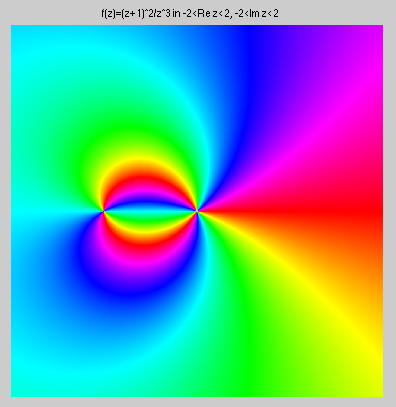
This is the phase portrait of a rational function. We can see that
there are two special points. As we go around the one on the left,
we cycle through the spectrum twice in the standard order: this is a
zero of order two. As we move around the one to the right, we cycle
through the spectrum three times in the wrong order: this is a pole of
order three. In fact, the function is f(z)=(z+1)^2/z^3, which does,
indeed, have a zero of order 2 at z= -1, and a pole of order
three at z=0.

This is the phase portrait of the same rational function, enhanced by contour lines of constant
absolute vaule.
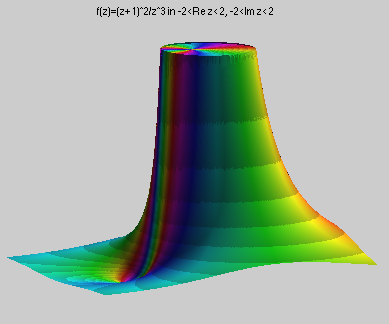
This is the analytic landscape of the same rational function. Many
features we saw clearly before, are obscured by the dominace of the
order three pole.
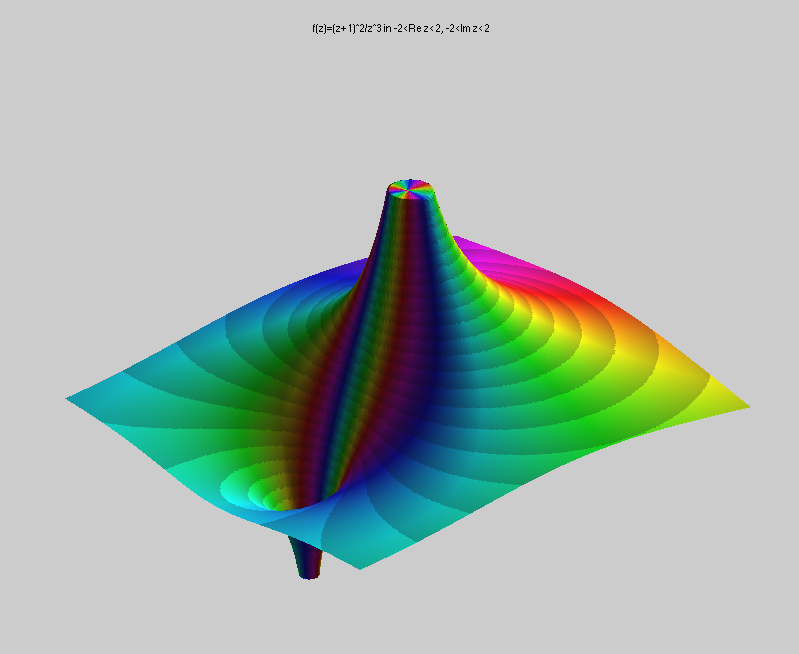
This is the logarithmic analytic landscape of the same rational
function. The colouring is the same, but the elevation is now given by
log|f(z)|. This emphasizes the zero (which now goes off to minus
infinity) and deemphasizes the pole.
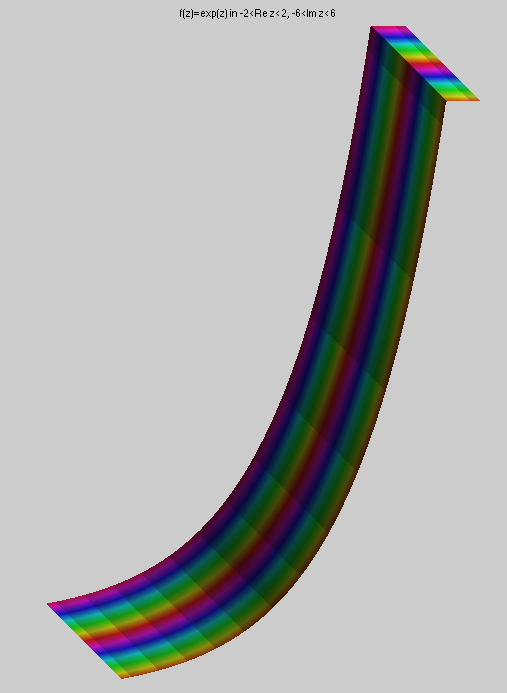
This is the analytic landscape of f(z)=e^z. The elevation is
|e^z|=e^(Re(z)), so it doesn't change in the imaginary direction (and
it is cut off near the top). The colour is given by arg(e^z)=Im(z), so
it doesn't change in the real direction, but keeps repeating in the
imaginary direction.




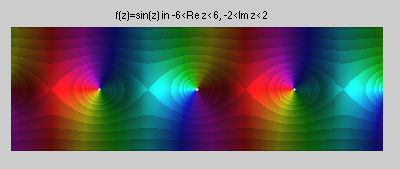
Above are five views of the analytic landscape of the complex sine
function.
Here are six rational functions and their phase portraits.
(A) (z+i)/(z-i) (6)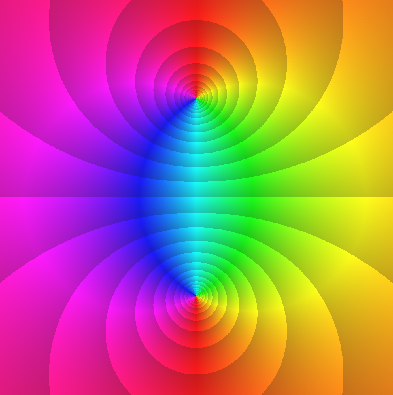
(B) (i+z)/(i-z) (1)
Both of the above functions have a simple zero at -i and a simple pole at i. One way to tell the difference between them is by evaluating them at z=0. For (A) we get -1, corresponding to cyan, for (B) we get +1, corresponding to red.
(C) (z+i)^2(z-i)^2 (3)
(D) (z-i)^2/(z+i)^2 (4)
The upper one has two double zeroes: one at i one at -i. The lower one has a double zero at i and a double pole at -i. So we can tell the difference between them by going around the point -i. In the former case we cycle through the spectrum in the standard order (zero), in the latter case we cycle in the wrong order (pole).
(E) (i+z)^3/(i-z) (2)
(F) (iz-1)^3/(i-z) (5)
These two have identical zero and pole behaviour at i and -i. Again, the easiest way to tell them apart is by evalutaing at 0. In the first case we get -1, corresponding to cyan, in the second case we get i, corresponding to chartreuse (half way between yellow and green).
back






















